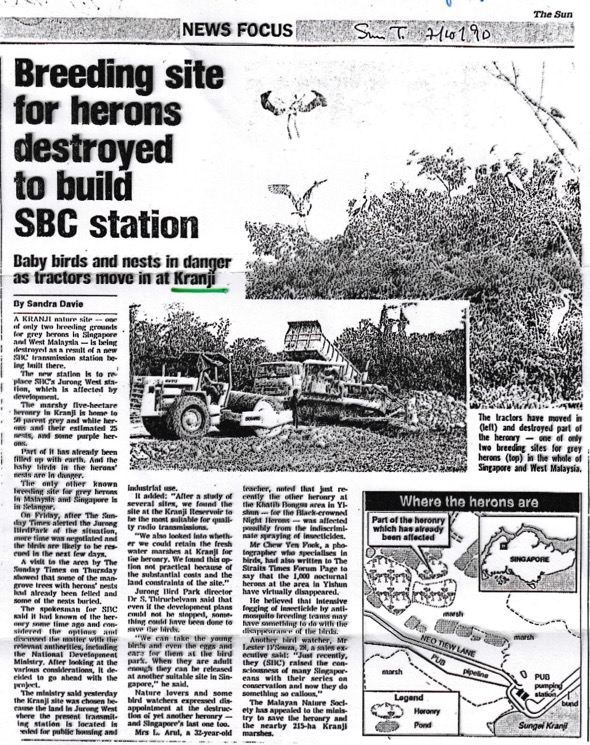Earlier posts: 1. Introduction; 2. Sungei Buloh.
One of the earliest conservation proposal completed by the Conservation Committee led by locals of the then Malayan Nature Society (Singapore Branch), now Nature Society (Singapore) was for the Kranji Heronry and Marshes (below). This was just after the Sungei Buloh proposal was completed. In September 1990 the proposal was sent to the then Minister for National Development.
The area was made up of degraded mangroves growing around the Kranji Reservoir. The main attraction was the 25 or so Grey Heron (Ardea cinerea) nests found in the trees near a farmhouse (below). In addition there were a few nests of the Purple Herons (Ardea purpurea).

The core heronry together with the buffer zone consisting of ponds and the marshy areas made up a total of 215 hectares. Together with the herons, the total number of bird species in the list of birds included in the report was 118.
By October 1990 the trees where the herons nested were felled followed by the clearing of the area (below). A Singapore Broadcasting Corporation station was eventually built on the site, claimed to be the most suitable for quality radio transmission. The Jurong West site where the station was located was scheduled for public housing and industrial use.

In hindsight, we were a naïve lot of amateur conservationists. For one, the habitat was made up of degraded vegetation – mangroves and freshwater marshes. The only value of the area was the so-called heronry. It developed because the area was isolated and seldom visited by people. Furthermore the few farmers there left the herons unmolested. Thus the vegetation was left to regenerate naturally and birds (including herons) proliferated.
In the report it was stated “the destruction of the area may mean a drastic decline of the Grey Heron population, not only the Kranji area but the whole of Singapore as well.”

Well, 13 years on, National Parks Board did a bird count where field ornithologist Wan Luan Keng was the coordinator (above). The four common heron species did decrease by as much as three-quarters, but according to Luan Keng, “not as bad as they look.” Obviously loss of nesting sites contributed to the decrease but definitely not as bad as predicted by the Nature Society in its 1990 proposal.
YC Wee
Singapore
4th April 2017
Secretary, Malayan Nature Society (Singapore Branch) 1978-1990; Founding President, Nature Society (Singapore) 1990-1995










One Response
Hi Yeow Chin,
Just a couple of points to add as I was around during all this.
Firstly, the role of the bird park in the destruction of the heronry. The authorities were in discussion and were heading toward building the station around the heronry when JBP stepped in to say that they would rescue all the nestlings. This confirmed the removal of the heronry and of all the chicks that they “rescued”, two-thirds were doomed to a life of captivity!
Secondly, the farmers did not leave the heronry unmolested as one farmer was found with several Grey and Purple Heron juveniles in cages by me. With the help of Chris Hails, the PRD and AVA confiscated these youngsters and most were successfully released at Kranji Bund.
Thirdly, as the heron studies only took place years later, the whole story is not apparent. Actually, the Grey Herons significantly declined along with the Purple Herons. The Greys moved to Johor, nested successfully there and mounted a return to Singapore with eventual success nesting at Pulau Ubin and Pasir Ris. The Purples have never recovered and until recently, the only nesting site was at the Singapore zoo grounds.
Fourthly, it must be remembered that along with the Kranji Heronry, 3 other Grey heronries, around Kranji, were destroyed within a year, effectively ending the species nesting here for a while. Likewise, the Purple Herons lost all their heronries, including those at Khatib Bongsu and Senoko. At the same time, all freshwater marshes, the main habitat of Purple Herons and other freshwater birds, were cleared with the same period. These were the 8 years when many green areas were cleared under a certain individual.
Today, the Grey Herons have mounted a successful comeback from Johor and no longer require the Vulnerable tag in the Red Data Book, with proper management and protection. The Purple Heron is still Endangered, as the Red Data Book indicates, but there are now 2 other small heronries known and freshwater marsh, a secondary habitat, is being protected at the Kranji Marsh Nature Park and is being created to enhance quarry pools and old fish ponds, like at Ubin.